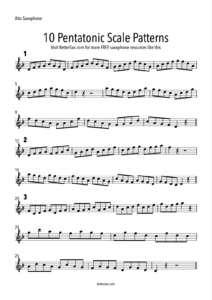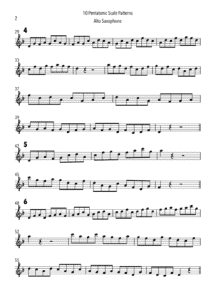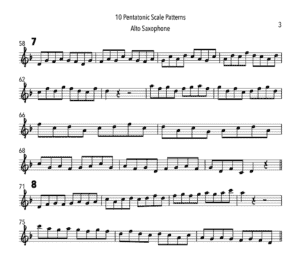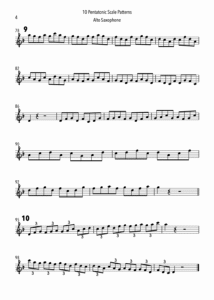
Practice Pentatonics Like this Everyday for Killer Solos
- By Jay Metcalf
- Saxophone-Lessons

Check out the audio podcast version of this post on Apple Podcasts or Spotify.
Do you ever wonder how some saxophone players play incredible solos that seem effortless?
After decades of teaching and performing around the world, I can tell you that it’s much more about how you practice rather than what you practice.
This article breaks down 10 awesome pentatonic scale patterns you can use to develop smooth, fast saxophone technique, solid rhythm, and killer improvisation chops. These exercises work on any saxophone, and you’ll find sheet music transposed for both alto and tenor in the free PDF. Click here to download the PDF.
Pattern 1
This first pattern is just the pentatonic scale going up and down. The key is to start on each note of the scale, which gives you five variations in total. At the end of each phrase, there’s a small skip that helps you move neatly into the next iteration.
The examples here are all in concert F minor. That allows everything to lay nicely on both alto and tenor saxophones. These should be played through the full range of your instrument—top to bottom—to get the most benefit.
Pattern 2
This one is a condensed version of the previous pattern. The notes are simply rearranged into a slightly different order. That’s the whole idea behind practicing scale patterns: training your fingers to handle the same material in different ways.
We’re not just learning licks—we’re building versatility and awareness that will show up naturally when improvising.
Pattern 3
Here, we’re displacing the starting note from Pattern 2 to create a new rhythmic and melodic shape. As with all these patterns, accuracy should be your top priority.
Only play at a tempo where you can play cleanly, with no mistakes. Slow, correct repetitions are what lead to fast and fluid playing later on. Mistake-filled practice leads to mistake-filled performance—so train carefully.

Pattern 4
This one introduces larger skips, which not only make the line more interesting but also challenge your fingers in new ways.
The patterns here aren’t in any specific order, and you should mix them up in your practice sessions. Choose two or three per day to warm up, but make sure to cycle through all ten regularly. Adding new material into your practice routine consistently will speed up your progress over time.
If you’re playing along with the examples, that’s fantastic. But remember—go at your own pace and focus on clean execution.
These patterns are written out in the free PDF download. BetterSax members also get access to an extended version of the PDF with additional patterns and a bonus hack that doubles your results.
Click here to learn more about joining the BetterSax membership.
Pattern 5
This one is often referred to as the Bergonzi pattern because it comes from his book. It’s a little more angular and challenging.
As you work through it, pay attention to any physical tension—particularly in the hands and shoulders. Excess tension negatively impacts your rhythm and can lead to pain or injury. Stay relaxed. Constantly check in with your body while practicing.
Pattern 6
Another straightforward variation of Pattern 2. Again, we’re just shifting the notes around in a slightly different way. What’s great is that you can apply these patterns to more than just the pentatonic scale. Try using the same exercises on your major scales and see how they feel.

Pattern 7
This variation builds off Pattern 4. It’s important to note that these patterns are not about plugging licks into your solos as written. Practicing them builds the flexibility and confidence that allows you to create freely in the moment.
Improvisation becomes much easier when you’ve spent time internalizing this kind of vocabulary.
Pattern 8
Pattern 8 shifts into groups of three notes, which creates a subtle rhythmic variation. These triplet-based groupings are great for developing fluid and varied phrasing.
When practiced thoroughly, this type of material becomes second nature. It’s not about memorizing licks—it’s about building a toolbox you can draw from creatively.

Pattern 9
This one begins descending, just to offer a different perspective. You might find that certain patterns sound better going down than up, and that’s totally fine.
The more you practice these, the more the musical phrases that sound good to you will naturally find their way into your improvisation. You don’t need to force it. Trust the process.
Pattern 10
This last one emphasizes rhythm by mixing in triplets, which instantly adds variety to your phrasing. Rhythm is the most important element in your playing, so spend focused time working on it.
Playing triplets comfortably requires deliberate practice. If you want to expand on this idea, BetterSax members can access a more in-depth version of this PDF where we apply these concepts to a lesser-known pentatonic scale that will instantly make your solos sound more unique.

Click here to download the free PDF and start practicing today.
Read this article next to discover the Most Important Scale for Jazz You’re NOT Using
More Posts
Jay Metcalf
Leave a Comment
Your email address will not be published. Required fields are marked *
COURSES FOR
EVERY LEVEL
filter by difficulty using the tabs
- All
- Advanced
- Beginner
- Bundle
- Free
- Intermediate
- All
- Advanced
- Beginner
- Bundle
- Free
- Intermediate






One Comment
Thank you for sharing all you do Jay! Your information has been very helpful in making me a better Saxophonist! I have played the pentatonic scales daily and they have helped me improve my intonation and technique.